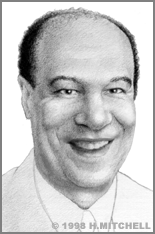Hildreth Walker
Hildreth “Hal” Walker, Jr. has won fame as an innovative thinker, collaborator and role model, in the realm of energy technology, especially in applications of lasers.
Born in Alexandria, Louisiana in 1933, Walker faced two major challenges as a young boy. On the one hand, his family forebade him from seeing his estranged father; on the other, African American persons were virtually forbidden from significant social or academic advancement. However, Walker visited his father on the sly, and on one memorable occasion received a toy Buck Rogers ray gun as a present. He also found a white family willing to let him work as an informal apprentice at their vacuum cleaner repair shop. Thus, by fighting the earliest obstacles he encountered, Walker gained both the inspiration and the experience that would lead him to a career in technology.
Walker’s family soon moved to Los Angeles, and through high school there, he sharpened his skills in mechanics and electronics. He had decided on a career in the film industry after graduating, but was shut out because he was African American. He could find work only with the Navy, installing radar systems in fighter planes. After the Korean War ended in 1953, his four years’ experience was ignored by employers.
In a few years, Walker got a long overdue big break. RCA hired him to help develop the U.S. government’s Ballistic Missile Early Warning System, designed to warn the U.S. in the event of a Soviet nuclear attack. Walker loved the work, and excelled at it. He went on to direct other global telecommunications projects, including the first television broadcast transmitted from Earth to a satellite and back to Earth again in 1962.
In 1969 came Walker’s most sensational success. Working for Union Carbide’s Laser Systems division, he led a team that adapted a ruby laser for measuring the distance from the Earth to the Moon during the Apollo 11 mission. Walker’s team trained a laser beam from Lick Observatory in California at a reflector mirror, only 18 inches wide, that Neil Armstrong and Buzz Aldrin had set up on the Moon’s surface. Walker’s team recorded by far the most accurate measurement of the distance ever, exact to within 5 meters. The equipment used for the experiment is now on permanent exhibit in the Smithsonian’s National Museum of American History.
Walker went on to join Hughes Aircraft, where he developed the first laser targeting systems for the U.S. Army in 1981. Since retiring from Hughes, Walker founded his own international laser systems consulting firm, Tech Plus in 1990, and co-founded, with his wife, Bettye, the African American Male Achievers Network, Inc., or “A-MAN” in 1991, which uses hands-on demonstrations and extracurricular projects to encourage and support boys’ and girls’ interests in careers in math, science and business.
Ever mindful of the obstacles that he himself surmounted, Hal Walker uses his expertise in technology to advance, not just science, but society.


